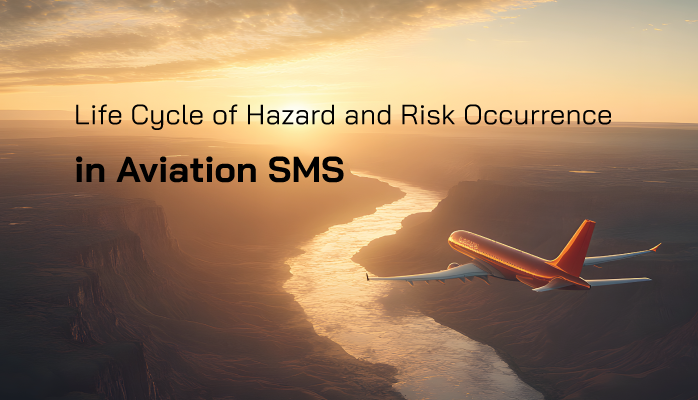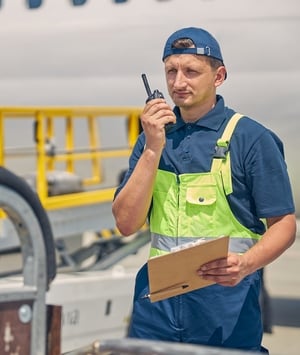What Is the Life Cycle of Hazard and Risk Occurrence?

The life cycle of hazard and risk occurrence is the entirety of an adverse event that happens in your company.
This life cycle has distinct stages that you can identify in any given event.
To put it in James Reason Swiss Cheese Model terms, the hazard/risk occurrence life cycle is the holes, the cheese, the mice, and everything in between.
Understanding this life cycle helps you answer important questions about safety events like:
- How did existing behaviors contribute to this event?
- How did this event escalate?
- What mechanisms caused this event to escalate?
- When did the hazard occur, and what was it?
- How did the SMS fail to mitigate this event?
Answers to these questions are fundamental to driving continuous improvement.
Before showing the life cycle of hazard and risk occurrence, we must define some common terms.
Important Aviation SMS Definitions
Safety definitions are important. They dictate how you view, understand, and organize your safety operations in your operational environment. We see a diverse array of how different terms are used across the aviation industry - different safety managers tend to have slightly different definitions of various elements of safety.
Regardless of whether you use these terms in exactly the same way, here are important safety definitions as they are used in this article:
- Hazardous sources: otherwise harmless things in the environment from which the adverse flow of events start (bird, mountain, building...);
- Initiating mechanisms/root causes: events, conditions, and interactions that start the adverse flow of events (behaviors, faulty equipment, environmental changes...);
- Hazard: a dangerous condition/situation that can lead to “something bad” (injury, accident, damage...);
- Hazard occurrence: a dangerous condition that happens in your operating environment, and requires immediate mitigation to reduce exposure to an acceptable level of safety;
- Risk: a combination of likelihood and severity of risk occurrence happening, OR likelihood of hazard occurrence and severity of most likely risk occurrence;
- Risk occurrence: “something bad” that happens in your operating environment (injury, accident, damage…) that results from hazard occurrence;
- Threat: also called “danger” and “exposure”, simply relates to the level of safety of your operational environment at any given time;
- Underlying Causes: preconditions, attitudes, Norms , behaviors, etc. that currently exist in your company, such as a Norm of "showing up to work at all costs, despite being sick";
- Damages/Consequences: the results of the “bad thing” that happens (risk occurrence), such as $1 million in damages, 40 dead, etc. - the difference between consequences and risk occurrence is not always clear.
You may find this article very useful: relationship between hazard and risk occurrence. Here are the stages in the life cycle of hazard and risk occurrence.
1 – Precursors to Risk
At any given time, even when your operations are currently under no threat, there are existing parts of your operations that can actively contribute to danger in certain circumstances. These underlying causes are:
- Attitudes;
- Behaviors;
- Knowledge level;
- SMS bureaucracy; and
- Less than optimal business/safety practices or processes.
Precursors are the origin point and underlying cause of nearly all events that are not successfully mitigated. They have a direct correlation to risk and are an integral part of causing initiating mechanisms through interaction with hazardous sources.
Related Aviation Hazard Identification Articles
- How to Develop a Hazard Reporting System in Aviation SMS [With Free Checklist]
- What Are Most Important Things to Know About Hazard Reporting in SMS
- What Good Hazard Reporting Process Look Like in Mature Aviation SMS
2 – Hazardous Sources Exist in Your Environment

Hazardous sources are often confused with hazards. Hazardous sources give rise to hazards. By themselves, hazardous sources are not dangerous but only become dangerous through some kind of interaction. Consider the following:
- Hazardous source: tall building;
- Hazard: tall building near flight path.
- Hazardous source: fuel;
- Hazard: open canister of fuel near flammable source.
Hazardous sources pose no inherent threat, but given the right circumstances, they can become a hazard. Hazardous sources usually become hazards through:
- Proximity (i.e., nearness);
- Condition (i.e., malfunctioning);
- Utility/function (i.e., not being used correctly).
Having a long list of hazardous sources can significantly help you when performing risk analysis, as they give you a starting point.
3 – Initiating Mechanisms (Root Causes) Start Adverse Flow of Events
Initiating mechanisms, also known as root causes, start the adverse flow of events. Initiating mechanisms are often:
- Choices one makes or doesn’t make;
- Breakdown in a particular process, procedure, task, or other bureaucratic element;
- Failure to communicate, be aware, practice teamwork, or any other Human Factor; and
- Mechanical problems, such as malfunctioning software or machinery.
Initiating mechanisms make hazardous sources become active threats.
4 – Rising Threat/Danger/Exposure Due to SMS Failures
Rising threat/danger/exposure is a convenient way of bridging the gap between root causes and hazard occurrence. Many people call rising threats “Contributory Factors.”
Root causes never lead directly to hazard occurrence – there are always intervening actions and events. Risk controls are designed to detect or prevent these intervening events. The rising danger is a complex topic and varies from safety event to safety event.
The point is that with any given safety event, you should carefully analyze it to see what contributed to the rising exposure.
5 – Hazard Occurrence
Aviation safety programs implement risk control measures to prevent adverse events from happening. Many of these risk controls target root causes, so that employees can recognize and report rising danger before hazard occurrence (see: what is a hazard in aviation SMS).
However, for many reasons, these root causes are not always identified, and a hazard occurs. We call this an SMS failure, which means:
- Risk controls failed to detect or prevent the rising danger of root causes; and
- Employees of hazard identification failed to spot the rising danger.
When a hazard occurs, there is always SMS failure involved. This is a tough pill to swallow.
Aviation SMS is always tasked with taking full responsibility for how it contributed to safety events. It’s not about “fairness” but about safety.
6 – Failure to Mitigate Hazard Occurrence

After a hazard occurs, employees are tasked with responding to the event (reactive risk management) in order to mitigate it and prevent a risk occurrence. Failure to mitigate is usually because:
- Employee actions failed;
- Risk controls failed; or
- Usually, a combination of both.
See: 5 mitigation strategies in aviation SMS.
This stage is very similar to contributory factors. However, failure to mitigate hazard occurrence results in events that lead from hazard occurrence to risk occurrence. It’s also a complex topic that requires a thorough investigation of a given safety event.
7 – Risk Occurrence
A risk occurrence is the “bad thing” at the end of the line. It is the culmination of all events. Risk occurrence is best described as the:
- Adverse point in the safety issue;
- Event that causes damages, injuries, etc.; and
- Event that leads to consequences (fallout).
Related Aviation Risk Articles
- What Is Risk vs Risk Occurrence in Aviation SMS
- How to Distinguish Hazard vs Risk Occurrence
- What Are Important Activities in Safety Risk Management (SRM)?
8 – Consequences of Risk Occurrence (Fallout)
After a risk occurrence, there is always fallout. Sometimes, people combine consequences and risk occurrence into the same thing. Consequences are usually things like:
- Amount of financial damage;
- Number of injuries/deaths;
- Effect on company reputation; or
- Non-compliance consequences.
As said, the line between the two is usually not very clear, as both risk occurrence and consequences are intimately tied together.
Last updated in January 2025.






